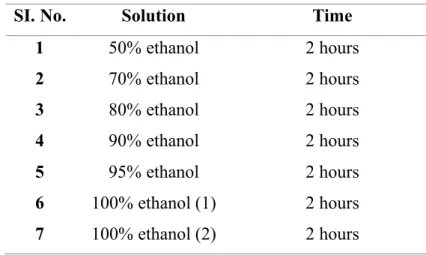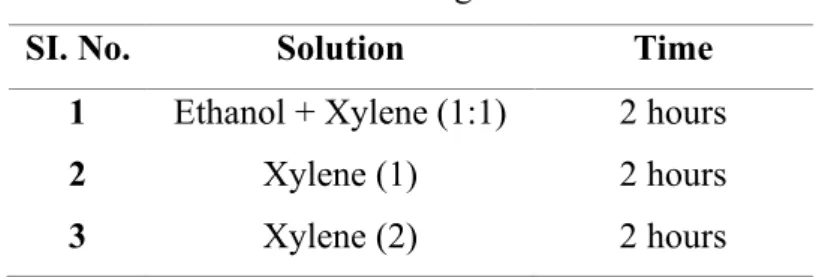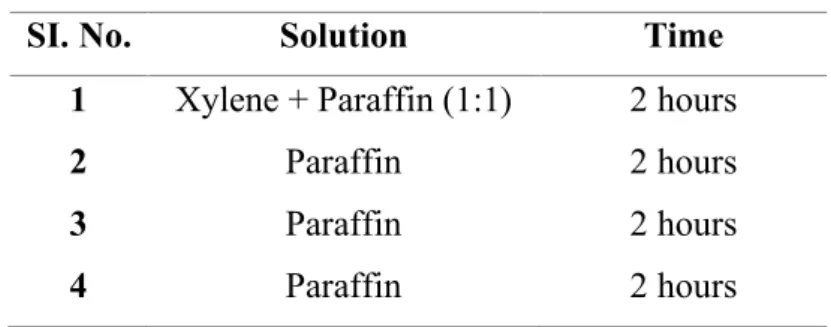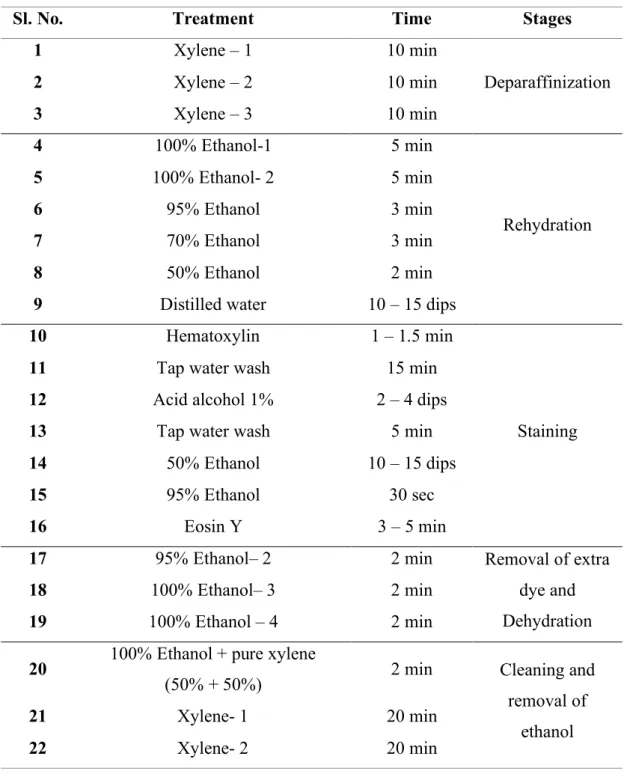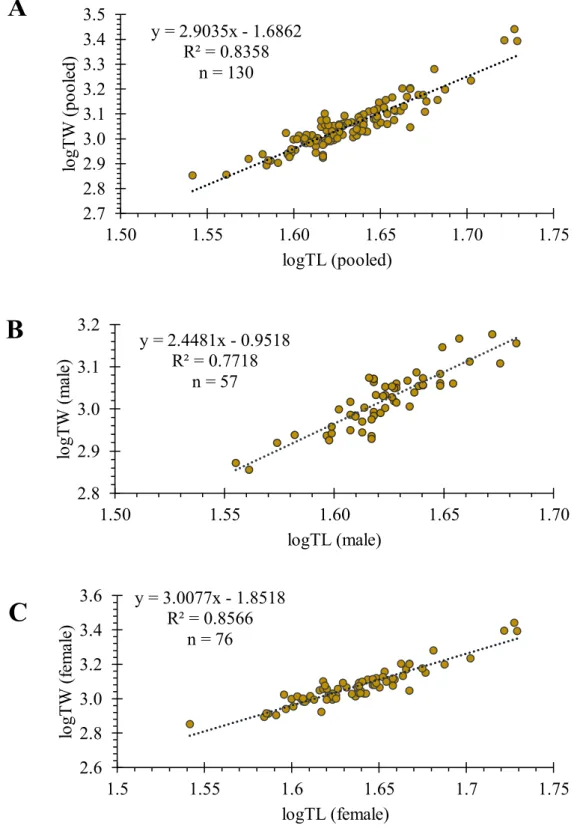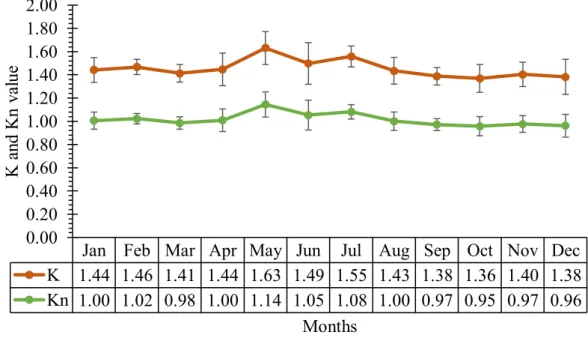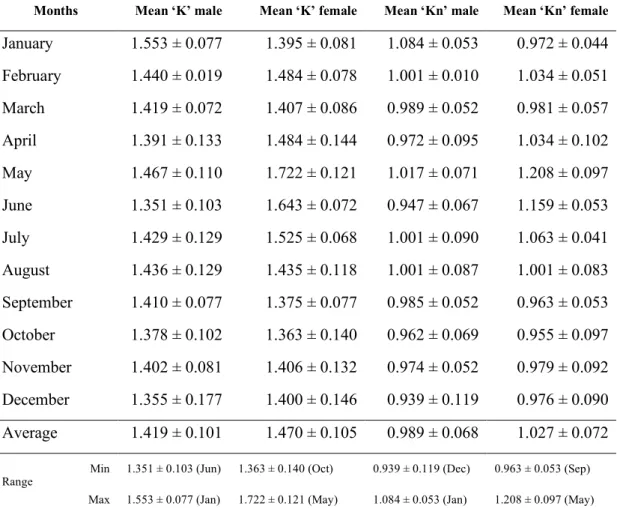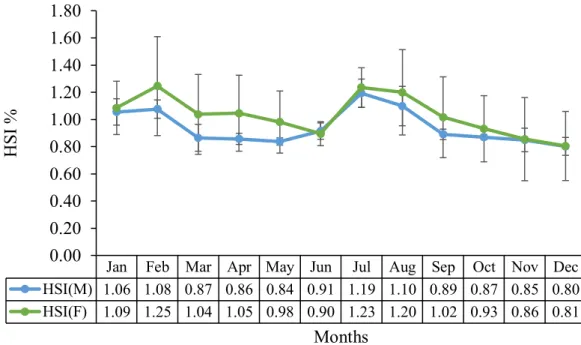Aims and objective of the research
6 ‒ 11
- Length-weight relationship and growth pattern
- Condition factor (K) and relative condition factor (Kn)
- Hepato-somatic index (HSI)
- Gonado-somatic index (GSI) and oocyte diameter
- Length at first sexual maturity (L m )
- Fecundity
- Reproductive biology and spawning season
- Sampling site and collection of samples
- Determination of the length-weight relationship
- Determination of condition factor (K) and relative condition
- Determination of gonado-somatic index (GSI) and hepato-
- Determination of length at first sexual maturity (L m )
- Determination of fecundity and oocyte diameter
- Histological analysis of gonad
- Statistical analysis
The "cube law" expresses the length-weight ratio, i.e. the weight of the fish will be proportional to the cube of their length, based on its dimensional similarity, which can be mathematically expressed as W = qLb (Allen, 1938; Brody and Lardy, 1946; Roy, 1987). Basak and Hadiuzzaman (2019) investigated the length-weight relationship of L. calbasu from the sample collected from the Tabalchari area of Kaptai Lake. In a study on the length-weight ratio of two important carp from Kaptai Lake, Ahmed and Saha (1996) reported the 'b' values of 3.13 and 3.15 for L. 1991) estimated the length-weight ratio of different size groups of L.
In addition, the comparison of different populations allows us to assess the quality of the habitats in which these animals live (Lima-Junior et al., 2002). The gonado-somatic index, often known as the GSI, is one of the traits considered in fish reproductive research. GSI can be used to determine whether gonads are hydrated, and consequently it is easier to determine the starting point of the breeding season by observing the increased gonad weight (Shinkafi and Ipinjolu, 2012).
Length at first sexual maturity is a topic of great interest in the fishing industry due to its frequent use as an indicator of the smallest size at which a fish can be legally caught (Lucifora et al., 1999). The amount of eggs present in the ovaries before the start of the mating season is used to estimate the fecundity of a species (Bagenal and Braum, 1978). Furthermore, it is also crucial to have a good understanding of the reproductive characteristics of fish so that we can make appropriate scientific recommendations for fisheries management (Hossain et al., 2017).
It used to be that the mating season in southern India began in late May, coinciding with the onset of the southwest monsoon, and lasted until late October (Chacko and Kurian, 1949). According to the aforementioned data, no significant information was found on the reproductive biology of the commercially important carp species, L. Fish samples (both male and female L. calbasu) were obtained from the local Banarupa Bazar fish market and the fish landing site of the fish. Bangladesh Fisheries Development Corporation (BFDC), Rangamati, Bangladesh (Figure 3).
After removing excess fat, blood vessels, and intestines, the gonads and liver were gently collected from the body cavity with forceps. Subsequently, the acetocarmine gonad pressing procedure was used to determine the sex of individual fish from the collected gonads (Guerrero and Shelton, 1974).
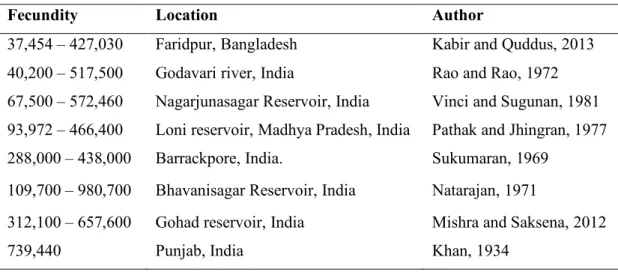
22 ‒ 43
Length-weight relationship and growth pattern
Condition factor (K) and relative condition factor (Kn)
Hepato somatic index (HSI)
The blue line indicates the HSI value for men, and the green line indicates the HSI value for women.
Gonado somatic index (GSI)
To investigate a possible relationship between GSI and HSI in both male and female L. Yet, there was no significant relationship between GSI and HSI for either male or female fish (R2 = 0.0079 for males and R2 = 0.0099 for females) (Figure 5), despite some opposing patterns in the peak and decline between the GSI - and the HSI value throughout the year (Figure 6). The blue color represents the GSI value and the gray color represents the HSI value.
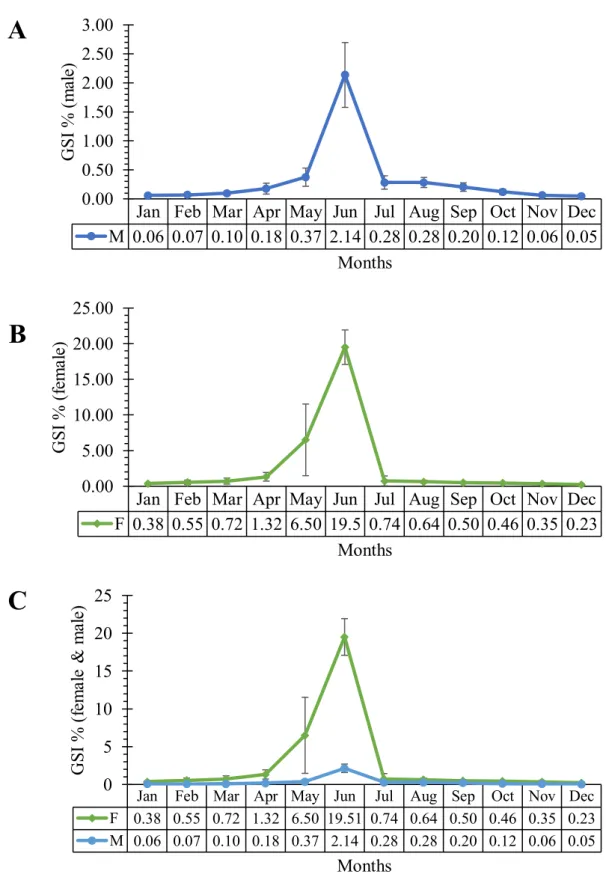
Oocyte diameter
Furthermore, the oocyte diameter data show a similar pattern of increase with the changes in GSI, suggesting that gonad development is timed to coincide with an increase in egg size (Figure 7B).
Length at first sexual maturity (L m )
In females, GSI, MGSI and DI all increased sharply just after 41.5 cm TL, which was considered the Lm for females collected from Lake Kaptai (Figure 8). Furthermore, GSI, MGSI and DI in males all increased sharply after 40.0 cm TL and were considered Lm for male L.
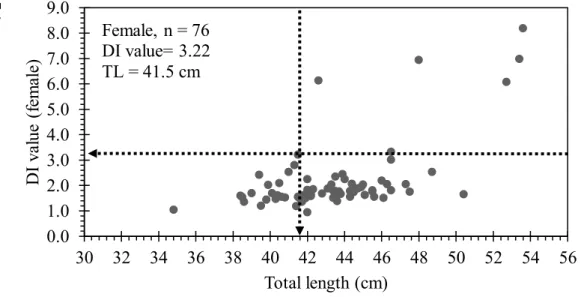
Fecundity
Gonadal development periodicity in females
The early primary vitellogenic phase is also known as the early maturation or secondary growth phase of the oocyte. The size of the ovary increases compared to the previous stage, turning from light yellow to light brown and occupying approximately one quarter of the peritoneal cavity. At the beginning of the primary vitellogenic phase, a large development in the diameter of the oocyte was seen, and the oocytes also became translucent and pink.
In ovarian histology, during this stage, the ovary is packed with early perinucleolar oocytes (Epo) and late perinucleolar oocytes (Lpo). The ovary was clearly in the growth phase in March (D) when the mean oocyte diameter was 152.7 µm and the mean GSI was 0.721%. In the histological examination of the ovary, eosinophils (bright pink) yolk globules are found to build up in the inner cortex as the secondary vitellogenic stage progresses.
In the general view of the ovary, some blood arteries were visible on the surface of the ovary. At this stage, most of the abdominal space was occupied by the greatly enlarged ovary, and the ovary was gray to bluish or turquoise in color. On histological examination of the ovary, many yolk granules were present in the ovarian follicle.
On the general appearance of the ovary, veins and arteries in the outer wall were clearly visible. Due to the release of the eggs, the mass of the ovary was greatly reduced, and the ovaries completely regressed. In a fully exhausted female, histology of the ovary revealed that the ovary contained several degenerating postovulatory follicles, a few atretic oocytes, and a few oogonia and oocytes in the perinucleolar phase; in a partially exhausted female, the ovary also contains oocytes in various vitellogenic stages (Figure 13).
Gonadal development periodicity in males
The general appearance of the testes was small, transparent, thread-like and pale white at this stage. The mesorchium holding them in the dorsal wall below the air bladder confined them to a small part of the body cavity. Histological examination of the testes revealed at this stage that the continuous germinal epithelium throughout the testis and the seminal lobule of the testes had a large number of spermatogonia but only a small number of spermatocytes.
The general appearance of testes was smaller in size, cylindrical in shape and translucent white at this stage. The histological examination revealed the continuous germinal epithelium in the periphery of the testes, while the discontinuous germinal epithelium was in lobules near ducts. In the histological examination of testes, all phases of spermatogenesis, including spermatogonia, spermatocytes and spermatids, were typically observed.
However, more spermatozoa were found in the lumen of the vas deferens of the testes at a late stage of development. In April (E) and May (F), the testes were found to be mature and ready to spawn. Growth of spermatids and spermatozoa in the lumen of the seminal lobule and seminiferous tubules was evident.
Mature spermatozoa were common in the peripheral testes, mid-ejaculatory ducts, and lumens (Figure 18). Histological examination of the testicles identified the spent testicles with discontinuous GE throughout the testicles, spermatocytes widely distributed, containing only secondary SC, ST or SZ. On the other hand, the histology of regressed testes was characterized by continuous GE of primary SG only and the presence of some residual SZ in the lumen.
44 ‒ 48
- Length-weight relationship and growth pattern
- Condition factor (K) and relative condition factor (Kn)
- Hepato-somatic index (HSI)
- Length at first sexual maturity (L m )
- Oocyte diameter
- Fecundity
- Gonado-somatic index, gonadal histology, and breeding
On the other hand, physiological, environmental, dietary and biological cycles may play a role in the lower Kn values in December due to low metabolic activity during winter. Male and female condition factors (K) have a similar trend throughout the year, peaking in May, indicating that the fish were in good condition before spawning, which is further explained by monsoon flooding and mild May weather. - July in the study area. In previous studies, Basak and Hadiuzzaman (2019) documented the mean condition factor and mean relative condition factor of 1.396 and 1.02, respectively, of L.
Fish with low water quality have smaller livers and less energy stored in the liver. Furthermore, there is a link between vitellogenesis and liver mass, as egg yolk and lipid droplets are synthesized in the liver and transferred to the oocyte during gonadal maturation. This is because fish do not use energy during their resting phase and have the lowest metabolic activity in December and January due to the winter season; thus they use the food stored in the liver.
Natarajan (1971) and Rao and Rao (1972) analyzed the Lm as 40 cm for males and 45 cm for females from Bhabanisagar Reservoir and Godavari River respectively. The differences in Lm may be due to variations in population, geographic region and condition of the fish. In the only study on oocyte diameter, Kabir and Quddus (2013) reported that the highest oocyte diameter was 1300 ± 40 μm from a pregnant L.
Fecundity is also one of the essential biological characteristics of fish when determining the reproductive capacity of a stock (Islam et al., 2008; Begum et al., 2010). However, Artesia and post-ovulatory follicles in the ovaries during July, August, September and October mean that the peak stage of maturity has passed during May and June. Based on GSI values and histological examination of fish gonads, it can be concluded that L.
49
50
In: 3rd Workshop on Fish Gonadal Histology, Joint Meetings of the American Society of Ichthyologists and Herpetologists and the American Elasmobranch Society. Efficacy of two inducers, PG and DOM+ sGnRH on induced reproduction of large carp, Kalibaus (Labeo calbasu). In: 3rd Workshop on Gonadal Histology of Fishes, Joint Meetings of the American Society of Ichthyologists and Herpetologists and the American Elasmobranch Society.
Observations on some aspects of the fisheries and biology of the mrigal, Cirrhinus mrigala (Hamilton) from Allahabad. Some aspects of the morphophysiography of Labeo calbasu (Ham.) from Rana Pratap Sagar reservoir, Rajasthan. Fertility and gonadosomatic index of Labeo calbasu (Hamilton) from a stocking pond of a hatchery in Faridpur, Bangladesh.
Biology of Labeo calbasu (Ham.) from Tilaiya reservoir, Bihar length-weight relationship, condition index and feeding habits. Length at maturity of the green shark, Squalus mitsukurii (Elasmobranchii: Squalidae), from the SW Atlantic, with comparisons to other regions. External morphological study of wild Labeo calbasu with reference to body weight 'total length and condition factor from river Chenab, Punjab, Pakistan.
Length-weight relationship, condition factor and food survey of Labeo calbasu (Hamilton) from Loni reservoir (Madhya Pradesh)[India]. Analyzes of protection and conservation under the Fisheries Act 1950 in Bangladesh's Kaptai Lake Fisheries Management. Growth pattern of "Labeo calbasu" (Ham) influenced by the socio-geographical condition of the river habitat.
